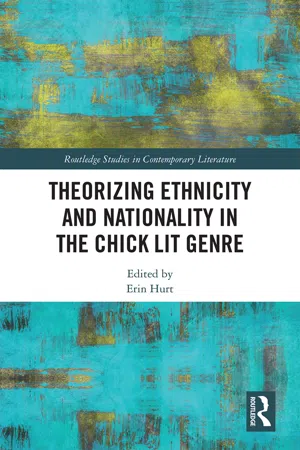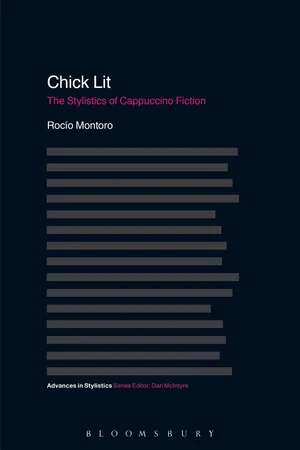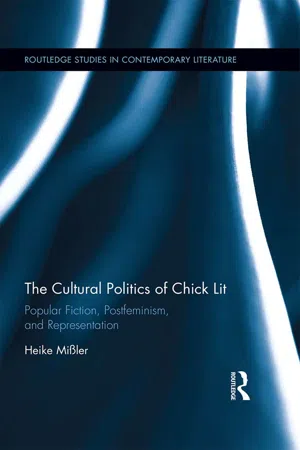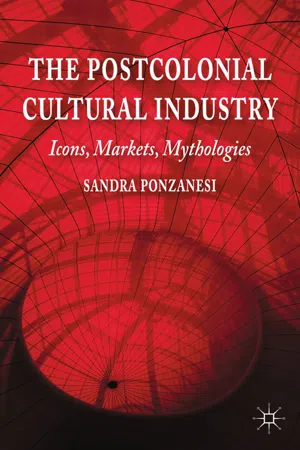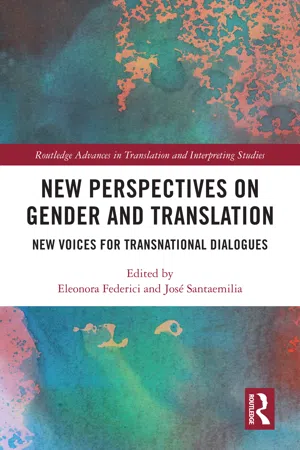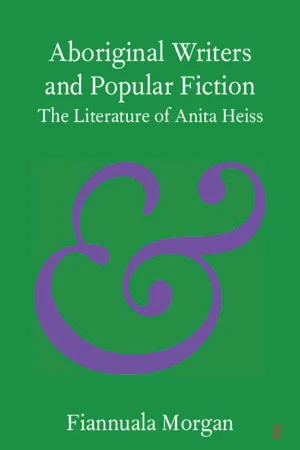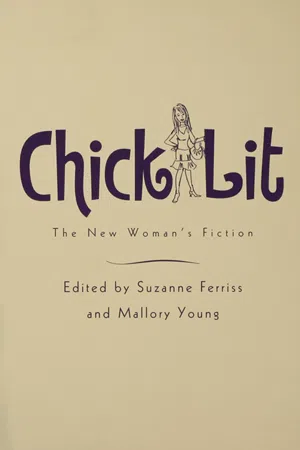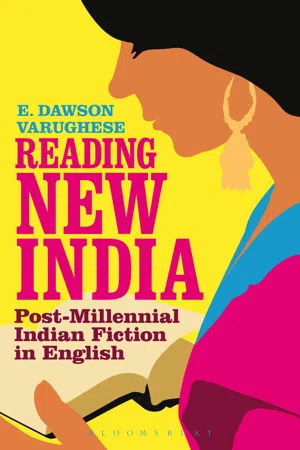Literature
Chick Lit
Chick Lit is a genre of fiction that typically features young, single, urban women as protagonists. The stories often revolve around their romantic relationships, career struggles, and personal growth. The term "Chick Lit" is often used in a derogatory manner, but the genre has gained popularity and has been embraced by many readers.
Written by Perlego with AI-assistance
Related key terms
1 of 5
12 Key excerpts on "Chick Lit"
- Erin Hurt(Author)
- 2018(Publication Date)
- Routledge(Publisher)
The phenomenon of Chick Lit, which includes both its emergence into the commercial realm and the multiplicity of ethnic categories it has come to include, deserves critics’ attention because this genre offers readers representations of women not seen before. These representations reflect the anxieties, opportunities, and possibilities of the present cultural moment in which women find themselves, almost as if women’s emotional, psychological, and economic struggles induced the novels that marked the commencement of this genre. Elsewhere, Imelda Whelehan articulates the underlying dilemma that these often-humorous novels probe, which is also one of the reasons readers found them appealing, writing, “today’s young women are burdened by the freedoms won by feminism and are, in fact, looking for a sense of order or some ‘rules’ that at least might bring some logic to their romantic lives” (5). Chick Lit functions as a site where women can see the reality of their lives, and when this genre first appeared in England and the US during the 1990s, readers were drawn to literature that finally seemed to depict the challenges they faced. Though many Chick Lit novels drew from conventions found in earlier women’s writing (such as marriage plots, confessional narrators, a diary format, the sex lives of single women, finding romance), they did so in a way that used these conventions to speak specifically to women’s experiences in the late twentieth and early twenty-first centuries.Chick Lit, at its moment of conception, told the story of women attempting to achieve—or perhaps simply define—success in the areas of romance, friendships, a career, and beauty. While not new, this narrative appealed to readers because of how it was told. They found appealing not just the first-person narration, the protagonist’s relatability, or even her search for the perfect happily ever after but the less obvious elements these novels divulged: the impediments that kept women from finding love, achieving professional success, understanding their ethnic identity, or negotiating multiple cultural and/or national communities. This was a time when women were being told by the media and popular culture that, post-Women’s Movement, they could “have it all”—a professional career, a successful marriage, children, beauty, intelligence, a good salary with benefits, and cultural belonging and acceptance—but many women, women of color especially so, quickly discovered that “having it all” was often unachievable. Chick Lit offered readers fictional heroines who attempted, often in humorous and relatable ways, to navigate this landscape where the promise of equality and opportunity did not match the actuality of a patriarchal, classist, and racist society. These depictions validated readers’ experiences by mirroring their frustrations and confusion.- eBook - PDF
Chick Lit
The Stylistics of Cappuccino Fiction
- Rocío Montoro(Author)
- 2012(Publication Date)
- Continuum(Publisher)
On the one hand, it seems that the cheerful and optimistic undertones of Chick Lit works have become nothing short of a trademark for the genre. Second, Yardley seems adamant that entertaining, that is, focusing on the amusing and ludic, is the main function of Chick Lit novels irrespective of whether this focus might detract from the literary merit of the works. The way my respondents portray their own version of what the genre seems to be about is quite enlight-ening, as they also echo, among other things, both the optimistic and the amusing aspects of the prototypical Chick Lit novel. For instance, of all the informants, only two failed to characterize Chick Lit in some shape or form; the rest volunteered definitions that suggest that, for them at least, Chick Lit has come of age and is not to be understood as a trendy, transitory fad, but as a genre that displays instantly recognizable traits clear and distinct from other manifestations of what could be categorized as women’s fiction. 16 As an illus-tration, consider the following comments: 4) I would say that Chick Lit usually encompasses a few different things, romance, some type of a bitchy woman, and they’re fun to read. 10) A novel written for an audience of females in their 20s and 30s that centers around one (or occasionally more) female protagonist in her 20s or early 30s struggling with relationship and work issues, usually in an urban setting. These issues are resolved within the course of the 166 Chick Lit novel, leaving the protagonist in a committed heterosexual relationship and in an exciting and promising career situation. - eBook - ePub
The Cultural Politics of Chick Lit
Popular Fiction, Postfeminism and Representation
- Heike Missler(Author)
- 2016(Publication Date)
- Routledge(Publisher)
L: Chick Lit is powerful, female fiction that tackles tough topics in a normally light hearted and careful way. It gives women a release and an escape from their everyday live. It is empowering and an extremely important genre.For two other bloggers who answered my survey, having a female lead character and being “interesting” to women (though no elaboration was given on why or how the texts are considered to be interesting to women), suffices for the classification of a novel into the chick-lit genre. However, all the others were more specific in their definitions and stress the diversity and the development of the genre, and its difference from other romantic fiction.C: I define Chick Lit as literature, either fiction or non-fiction, aimed at a female audience, ages 20 - 50 (in my opinion). Chick Lit writing is often humorous with quirky main characters. Chick Lit books generally explore issues that women in this age group would encounter, such as finding love, diet, exercise, choosing a career, becoming more assertive, etc. There is an incredibly wide selection of books considered Chick Lit, ranging from light- hearted, cute novels about dating, shoe shopping and running cupcake shops, to more weighty, dramatic novels about marriage, death, infidelity, and more.S: The main character must be female and older than 18. Setting must be in contemporary times (we do go back to about the 1980s). Chick Lit, not traditional romance (which is all about girl meets boy, Chick Lit includes the other aspects of her life).So even though the bloggers’ definitions vary, these different personal approaches neither weaken the sense of community nor the validity of their canon or the criteria for their reviews, because Chick Lit as a genre can accomodate all of these definitions. The responses also show that there is an awareness that Chick Lit has been artificially created as a marketing label, and that the power to decide what to understand by it lies very much in the hands of the fans. In the end, it is up the individual blogger which texts she chooses to include, how she argues that they belong to the chick-lit canon or not, and how she assesses them as such. - eBook - ePub
The Postcolonial Cultural Industry
Icons, Markets, Mythologies
- S. Ponzanesi(Author)
- 2014(Publication Date)
- Palgrave Macmillan(Publisher)
vis á vis issues of feminist empowerment considering its entanglement with postcolonialism and the cultural industry.6.1.1 What is Chick Lit?Chick Lit has received both scathing criticism and utter adoration from its fans, the chickerati. Critics disdain it because they consider it ‘frilly’, ‘trash’, ‘fluffy’, ‘mind-numbing garbage’ or ‘formulaic vapid prose’. And yet, the emergence of Chick Lit is an interesting new phenomenon, as it is not only market driven but also engages with complex or contestable forms of feminist empowerment. It is not only that it is written by women for women, but also that it addresses pressing issues for women such as career, sexuality and desire.The term was inadvertently coined by novelist Cris Mazza in 1995, when co-editing a volume entitled, ironically and polemically, Chick-Lit: Postfeminist Fiction (1995), which was followed by another co-edited volume, Chick-Lit: No Chick Vics (1996). Cris Mazza was the first to use the term ‘Chick Lit’ in print, but it was used ironically. She could not have anticipated that her mocking use of the term would later re-emerge as a kind of brand name in the publishing industry, which soon spread to denote also chick movies and TV series, and a chick culture in its own terms.2From the literary criticism perspective, we can define it as a form of women’s fiction on the basis of the subject matter, character, audience and narrative style. As Heather Cabot defines it, ‘Simply put, Chick Lit features single women in their twenties and thirties “navigating their generation’s challenges of balancing demanding careers with personal relationships” ’ (Cabot 2003). They are ‘formula stories’ about women, usually singletons, living in urban centres such as London, Manhattan or Dublin, with challenging careers, often in publishing, television or journalism (with some exceptions in the legal profession such as Ally McBeal and Legally Blonde). These are women battling with Harlequin’s ideas of romantic love and the need to experiment with multiple sexual partners (as in Sex and the City - eBook - ePub
New Perspectives on Gender and Translation
New Voices for Transnational Dialogues
- Eleonora Federici, José Santaemilia, Eleonora Federici, José Santaemilia(Authors)
- 2021(Publication Date)
- Routledge(Publisher)
In 1995, this term, imbued with highly gendered connotations of commercialism and superficiality, was adopted by Mazza and Deshell in their anthology Chick Lit: Postfeminist Fiction. Nevertheless, the Chick Lit genre gained popularity during the 1990s thanks to the publication of Helen Fielding’s Bridget Jones’s Diary (1996) in the United Kingdom, which is widely cited as the key founding text (Ferriss and Young 2006; Davis-Kahl 2008; Knowles 2008; Gill and Herdieckerhoff 2006), and Sex and the City (1997) by Candace Bushnell in America, which was later adapted into the popular television series of the same name. In 2001, Harlequin Enterprises launched Red Dress Ink, a company devoted exclusively to the publication of Chick Lit novels. Further to this event, other publishing companies, such as Simon & Schuster and Kensington, decided to have special branches aimed at publishing Chick Lit novels. The term Chick Lit is made up of two words that have negative connotations, namely “chick,” a slang word used to refer to a girl or young woman, and “lit,” the shortened version of literature, denoting frivolity or insignificance. Chick Lit is commonly regarded as a subgenre of romance and popular fiction and it is sometimes defined as “singleton literature” as it clearly deals with the lives of female singletons. Since its inception in the 1990s, Chick Lit has continued to expand on and diversify its formula to include different subgenres, such as Chick Lit Jr, written about teenage protagonists for a young adult readership, or Mummy Lit, referring to women’s stories and demands of motherhood. There are also some novels featuring middle-aged protagonists that are becoming increasingly known as Hen Lit. The list of these subgenres is endless; it also includes Church Lit and Ethnic Lit, the latter of which is further divided into e.g. Ladki Lit, Chica Lit, and Sistah Lit, respectively drawing on Indian Chick Lit, Latina Chick Lit, and African American Chick Lit - eBook - PDF
Aboriginal Writers and Popular Fiction
The Literature of Anita Heiss
- Fiannuala Morgan(Author)
- 2021(Publication Date)
- Cambridge University Press(Publisher)
3.1 Definition, Origin and Significance of Chick Lit Academic and industry understandings of the genre present the pursuit of a career, love and shopping as uniformly constitutive of Chick Lit. That is, through first-person narration, an urban-based woman heavily invested in consumer culture ‘comes of age’ or ‘consciousness’ through episodes of dating (Yardley, 2006: 4). Since its inception – heralded by the publication of Bridget Jones’s Diary (1996) – the genre has been lambasted for its frivolity and superficiality. In 2001, Booker Prize nominee Beryl Bainbridge denounced the genre as ‘a froth sort of thing’ concerned with ‘helpless girls, drunken, worrying about their weight and so on’ (quoted in Ferriss and Young, 2006: 1). A lack of profundity or originality is a common critique, and the title of Chick Lit has become so offensive to some that anthologies have even been compiled in opposition to the term. This is Not Chick Lit (2006) edited by Elizabeth Merrick is a compilation of women’s short fiction, that is emphatically not Chick Lit. Merrick defines the genre in the following terms: Aboriginal Writers and Popular Fiction 33 Chick Lit is a genre, like a thriller, the sci-fi novel, or the fantasy epic. Its form and content are, more or less formu- laic: white girl in the big city searches for Prince Charming, all the while, shopping, alternately cheating on or adhering to her diet, dodging her boss, and enjoying the occasional teary-eyed lunch with her token Sassy Gay friend. (vii) Merrick and Bainbridge dismiss the genre of Chick Lit on the grounds of its supposed frivolity and superficiality. A modest number of advocates, however, refute this and argue for the genre’s substantive nature based on its historical affiliations and cultural significance. - eBook - PDF
Books and Beyond
The Greenwood Encyclopedia of New American Reading [4 volumes]
- Kenneth Womack(Author)
- 2008(Publication Date)
- Greenwood(Publisher)
Some commentators voice reservations about the conno- tations of the term “Chick Lit.” Curtis Sittenfield of The New York Times writes: “To suggest that another woman’s ostensibly literary novel is Chick Lit feels catty . . . doesn’t the term basically bring down all of us?” (“Sophie’s,” 2005). Other com- mentators express concern that Chick Lit has closed down other narratives for women. Stacey D’Erasmo laments the paucity of plots reflected in contemporary popular women’s fiction: “the marital quest of the fashionable, sexually well- traveled, 30-something woman has become so popular as to seem like the dominant narrative of life on earth right now” (Howard 1999). In an article for Book Magazine, Anna Weinberg parodied the genre by compiling a “Make Your Own Chick Lit” recipe, listing the formulae of the successful Chick Lit novel (Harzewski 2005, 34). Some writers welcome associations with Chick Lit. Valdes-Rodriguez views the genre as a vehicle for delivering her “message”: “I like being called a beach read. I don’t want to preach to the choir. I can sit here and say Latinos come in all shades for the rest of my life and no one would care. I’m trying to create a human being in a fun, fashion-y way and get the message across” (Acosta 2006). In 2005, Suzanne Ferriss and Mallory Young edited a lively collection of essays entitled Chick Lit: The New Woman’s Fiction, outlining the themes and preoccu- pations of the genre as well as its limitations. The essays focus specifically on Chick Lit’s cultural significance. Imelda Whelehan examines Chick Lit’s embattled relation- ship with feminism in detail in The Feminist Bestseller. She observes that “feminism lurks in the background” of much Chick Lit “like a guilty conscience” (Whelehan 2005, 176). Whelehan acknowledges that the genre engages women readers for whom feminism has lost its currency: “Chick Lit is built on a tacit acknowledge- ment that feminism has failed to speak to ‘ordinary’ women” (214). - eBook - ePub
Culture, Health, and Religion at the Millennium
Sweden Unparadised
- M. Demker, Y. Leffler, O. Sigurdson, M. Demker, Y. Leffler, O. Sigurdson(Authors)
- 2014(Publication Date)
- Palgrave Macmillan(Publisher)
When it is applied to novels, they are often considered to be stories about women and women’s issues, written by women writers for women readers. Compared to most romance literature, Chick Lit is about a slightly older woman: a single, professional protagonist in her thirties, sometimes in her late twenties or early forties. The novels illustrate what happened after Cinderella was united with the prince and the difficulties she confronted when she was supposed to live happily ever after. Many narratives start when the heroine is dumped by Prince Charming and has to face new challenges as well as a variety of romantic, personal, and professional dilemmas. Still, most Chick Lit novels are structured according to the romance formula. They tell the story of the female character’s meeting with a new and better man and the unfolding of their romantic relationship. They often contain what Pamela Regis calls the eight narrative elements of romance novels: “a definition of society, always corrupt, that the romance novel will reform; the meeting between the heroine and hero; an account of their attraction for each other; the barrier between them; the point of ritual death ; the recognition that fells the barrier; the declaration of heroine and hero that they love each other; and their betrothal.” 2 Nonetheless, Chick Lit distinguishes itself from the traditional romance novel in many ways. Most Chick Lit novels could be called “city girl books.” 3 They are structured around an urban female protagonist and her middle-class aspirations and lifestyle; a protagonist who has a desire for upward mobility and, according to J. Knowles, is “seeking fulfillment in a romance-consumer-comedic vein.” 4 To be more exact, Chick Lit novels are known for promoting a glamorous lifestyle. The stereotypical, Chick Lit protagonist in many Anglophone novels is urged to overspend in a consumer society in her quest for Mr - eBook - ePub
Chick Lit
The New Woman's Fiction
- Suzanne Ferriss, Mallory Young(Authors)
- 2013(Publication Date)
- Routledge(Publisher)
Novelist Cris Mazza, coeditor of Chick-Lit: Postfeminist Fiction (FC2, 1995) and Chick-Lit: No Chick Vics (FC2, 1996), argues convincingly that she was the first to use the term “Chick Lit” in print—but for ironic purposes. In “Who’s Laughing Now?: A Short History of Chick-Lit and the Perversion of a Genre,” she traces how the term worked its way into print after her anthologies were published and reviewed, focusing on the difference between her mocking use of “Chick Lit” and its subsequent emergence as a type of brand name in the publishing industry. In the ten years since Mazza and her coeditor Jeffrey DeShell first used the term, Chick Lit has acquired a fixed definition, mocked not only in the “Chick Lit 101” article but also in various recipes and formulas published in the popular press. From the perspective of literary criticism, we can define it as a form of women’s fiction on the basis of subject matter, character, audience, and narrative style. Simply put, Chick Lit features single women in their twenties and thirties “navigating their generation’s challenges of balancing demanding careers with personal relationships” (Cabot). As popular women’s fiction, Chick Lit has been likened to the contemporary romance popularized by Harlequin in the United States and Mills and Boon in Britain. 1 But here, too, the connection might be an ironic one. Janice Radway’s influential work on the romance identifies that genre’s single unassailable tenet: the primacy of the male-female couple. The heroine must be connected with one, and only one, man. Yet, as Stephanie Harzewski explains in her essay “Tradition and Displacement in the New Novel of Manners,” that requirement, along with others, has been subtly subverted by chick-lit novels - eBook - ePub
Reading New India
Post-Millennial Indian Fiction in English
- E. Dawson Varughese(Author)
- 2013(Publication Date)
- Bloomsbury Academic(Publisher)
3 Chick Lit to crick litChapter 3 investigates the rise in Chick Lit and crick lit (my term) narratives. Advaita Kala’s Chick Lit novel Almost Single (2007) is a seminal work in the evolution of Chick Lit within the Indian publishing scene. Her book explores what it is to be young and female in India today and this novel is analysed along with Chauhan’s Battle for Bittora (2010), a novel that brings the Chick Lit genre together with a political narrative and contemporary boy-meets-girl plot. Section 3.2 considers the recent body of fiction on cricket, ‘crick lit’ as I term it, and this presentation includes analysis of The Premier Murder League (2010) by Geeta Sundar and The Zoya Factor (2008) by Anuja Chauhan.3.1 Chick LitToday’s body of writing that we might call ‘Chick Lit’ is mainly written by women, with a female protagonist who, in various ways, faces challenges, questions and changes in contemporary Indian society, these narratives often include a ‘love’ or ‘romance’ element and are often narrated humourously. However, there are a few exceptions, see: With or Without You (2010) by Partha Sarathi Basu, Love Over Coffee (2010) by Amrit N. Shetty and Chocolate Guitar Momos (2011) by Kenny Deori Basumatary. These male-authored narratives, although stories of ‘romance’ (in various guises), have less emphasis on the female protagonist as they are told from the male perspective.Today’s canon of Chick Lit might be considered alongside female narratives that have been published earlier in the history of writing in English in India. The work of Shashi Deshpande, Anita Desai, Shama Futehally, Temsula Ao, Nisha da Cunha, Kamala Markandaya as well as other women writers with recent novels in publication such as Jaishree Misra and Manju Kapur, all have engaged with female narratives. Lau (2006) writes of the emotional and domestic territories which are so often explored in the fiction of these writers, stating: ‘their writings frequently include detailed descriptions of the interior spaces of home, the negotiation of roles and hierarchies, and the emotional lives played out against a background of the bedroom and the kitchen’ (Lau - eBook - PDF
Bring on the Books for Everybody
How Literary Culture Became Popular Culture
- Jim Collins(Author)
- 2010(Publication Date)
- Duke University Press Books(Publisher)
To suggest that another woman’s ostensibly literary novel is chick-lit feels catty, not unlike calling another woman a slut—doesn’t the term basically bring down all of us? And yet, with The Wonder Spot , it’s hard to resist. A chronicle of the search for personal equilibrium and Mr. Right, Melissa Bank’s novel is highly readable, sometimes funny and entirely unchallenging: you’re not a lot smarter after finishing it. I’m as resistant as anyone else to the assumption that because a book’s author is female and because that book’s protagonist is a woman who actually cares about her romantic future, the book must fall into the chick-lit genre. So it’s not that Bank’s topic is lightweight; it’s that she writes about it in a light-weight way. (9) By beginning with “ostensibly literary” this critique makes it quite clear that Sittenfeld knows full well that there is a category of fiction out there that makes claims for literary status but she doesn’t think it’s warranted. She shares certain premises with Weiner: that there is indeed a vast difference between what is considered truly literary and mere chick-lit, and that to as-sume that women writing about women in love automatically puts a novel in 1 POPULAR LITERARY FICTION the latter category is offensive, but critics keep doing it anyway. But Sitten-feld parts company with Weiner and Bank by saying, in effect, that this disdain is merited because most chick-lit is just bad writing; so, ultimately, the fault is with the people who write it, not the people who review it. Craft is reasserted here as the key distinguisher of literary fiction, and Bank is on the other side of the divide because her writing is lightweight. The key difference between Weiner and Sittenfeld, then, is a matter of evaluative criteria. - eBook - ePub
Gender(ed) Identities
Critical Rereadings of Gender in Children's and Young Adult Literature
- Tricia Clasen, Holly Hassel, Tricia Clasen, Holly Hassel(Authors)
- 2016(Publication Date)
- Routledge(Publisher)
Horn Book Magazine 80, no. 6 (November 2004): 669–77, 670.- 3. Joanna Webb Johnson, “Chick Lit Jr.: More than Glitz and Glamour for Teens and Tweens.” In Chick Lit: The New Woman’s Fiction. Edited by Suzanne Ferris and Mallory Young, 141–58 (New York and London: Routledge, 2006), 146.
- 4. As Webb Johnson points out, however, critics disagree on the orthodoxy of the feminist discourses of adult Chick Lit. My point, here, is not to debate whether that genre is feminist, but rather to show that criticism of teen Chick Lit tends to take the position that it is less feminist than its adult version.
- 5. Joanna Webb Johnson has noted that in adult Chick Lit, “the characters often seem to be adolescent in at least one aspect of their lives” and that “both versions of the genre usually feature stages of emotional and sexual maturity for their protagonists or, at their best, a grand moment of self-realization.” Webb Johnson, “Glitz and Glamour,” 142.
- 6. Sarra Manning, Guitar Girl (New York: Penguin, 2005 ), 9.
- 7. Manning, 25.
- 8. Gérard Genette defines the paratext as “what enables a text to become a book and to be offered as such to its readers and, more generally, to the public.” Gérard Genette, Paratexts: Thresholds of Interpretation. Trans. Jane E. Lewin (Cambridge: Cambridge University Press, 1997), 1.
- 9. Gérard Genette, Paratexts, 135.
- 10. These musicians are also named by Jennifer Baumgardner and Amy Richards, authors of Manifesta, as icons of third-wave feminism with whom they feel affiliated. Manifesta’s relationship to third-wave feminism will be detailed below.
- 11. Yvonne Tasker and Diane Negra, Interrogating Postfeminism_ Gender and the Politics of Popular Culture
Index pages curate the most relevant extracts from our library of academic textbooks. They’ve been created using an in-house natural language model (NLM), each adding context and meaning to key research topics.
